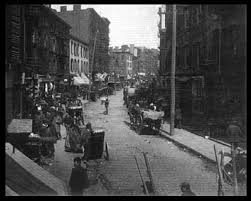
In class: vocabulary test on "Outcasts"
In class: we are continuing with an excerpt from How the Other Half Lives by Jacob Riis. This investigative report will serve as the "real life" counterpart to Stephen Crane's novel Maggie, Girl of the Streets, which we will begin on Tuesday.
Assignment: read the accompanying questions FIRST, then read the Introduction to How the Other Half Lives. When you have have finished, select three of the six questions and write a 50 word response for each one. This is due at the close of class on Monday. (class handout / copy below)
Suggestion: use the handout from yesterday entitled "The Genesis of the Tenement" for an additional resource. The responses should contained lots of textual information.
How the Other Half Lives (1890) Jacob Riis
Introduction
The rapid growth of industrialization in the United States
of the 1880s created an intense need for labor. The flood of tens of thousands
of people— of them immigrants— northeastern cities created a housing problem of
major proportions. Landlords, rushing to realize quick profits, persisted in
subdividing their apartments into ever smaller units, forcing the poor into
increasingly overcrowded living conditions.
Excerpt from Jacob
Riis’ How the Other Half Lives
Riis's work helped spark a new approach to reporting called
"muckraking" that eventually led to the Progressive Era reform
movements to improve these conditions. We previously read “The Genesis of the
Tenement.” Now we’ll look more closely
at the lives of the people who lived there.
First read the
questions that accompany this excerpt. Select three questions that you would
like to answer in a well-written, text- based response of a minimum of 50 words
each. Then read the excerpt, underlining or highlighting material that you
might want to incorporate into your responses.
The twenty-five cent
lodging-house keeps up the pretense of a bedroom, though the head-high
partition enclosing a space just large enough to hold a cot and a chair and
allow the man room to pull off his clothes is the shallowest of all pretenses.
The fifteen-cent bed stands boldly forth without screen in a room full of bunks
with sheets as yellow and blankets as foul. At the ten-cent level the locker
for the sleeper's clothes disappears. There is no longer need of it. The tramp
limit is reached, and there is nothing to lock up save, on general principles,
the lodger. Usually the ten- and seven-cent lodgings are different grades of
the same abomination. Some sort of an apology for a bed, with mattress and
blanket, represents the aristocratic purchase of the tramp who, by a lucky
stroke of beggary, has exchanged the chance of an empty box or ash-barrel for
shelter on the quality floor of one of these "hotels." A strip of
canvas, strung between rough timbers, without covering of any kind, does for
the couch of the seven-cent lodger who prefers the questionable comfort of a
red-hot stove close to his elbow to the revelry of the stale-beer dive. It is
not the most secure perch in the world. Uneasy sleepers roll off at intervals,
but they have not far to fall to the next tier of bunks, and the commotion that
ensues is speedily quieted by the boss and his club. On cold winter nights,
when every bunk had its tenant, I have stood in such a lodging-room more than
once, and listening to the snoring of the sleepers like the regular strokes of
an engine, and the slow creaking of the beams under their restless weight,
imagined myself on shipboard and experienced the very real nausea of
sea-sickness. The one thing that did not favor the deception was the air; its
character could not be mistaken.
The proprietor of one of
these seven-cent houses was known to me as a man of reputed wealth and
respectability. He "ran" three such establishments and made, it was
said, $8,000 a year clear profit on his investment. He lived in a handsome
house quite near to the stylish precincts of Murray Hill, where the nature of
his occupation was not suspected. A notice that was posted on the wall of the
lodgers' room suggested at least an effort to maintain his up-town standing in
the slums. It read: "No swearing or loud talking after nine o'clock."
Before nine no exceptions were taken to the natural vulgarity of the place; but
that was the limit.
There are no licensed
lodging-houses known to me which charge less than seven cents for even such a
bed as this canvas strip, though there are unlicensed ones enough where one may
sleep on the floor for five cents a spot, or squat in a sheltered hallway for
three. The police station lodging-house, where the soft side of a plank is the
regulation couch, is next in order. The manner in which this police bed is
"made up" is interesting in its simplicity. The loose planks that
make the platform are simply turned over, and the job is done, with an
occasional coat of whitewash thrown in to sweeten things. I know of only one
easier way, but, so far as I am informed, it has never been introduced in this
country. It used to be practised, if report spoke truly, in certain old-country
towns. The "bed" was represented by clothes-line stretched across the
room upon which the sleepers hung by the arm-pits for a penny a night. In the
morning the boss woke them up by simply untying the line at one end and letting
it go with its load; a labor-saving device certainly, and highly successful in
attaining the desired end. . . .
. . . If the tenement is
here continually dragged into the eye of public condemnation and scorn, it is
because in one way or another it is found directly responsible for, or
intimately associated with, three-fourths of the miseries of the poor. In the
Bohemian quarter it is made the vehicle for enforcing upon a proud race a
slavery as real as any that ever disgraced the South. Not content with simply
robbing the tenant, the owner, in the dual capacity of landlord and employer,
reduces him to virtual serfdom by making him become his tenant, on such terms
as he sees fit to make, the condition of employment at wages likewise of his
own making. It does not help the case that this landlord employer, almost
always a Jew, is frequently of the thrifty Polish race just described. . . .
. . . Probably more than
half of all the Bohemians in this city are cigarmakers, and it is the herding
of these in great numbers in the so-called tenement factories, where the
cheapest grade of work is done at the lowest wages, that constitutes at once
their greatest hardship and the chief grudge of other workmen against them. . .
.
Men, women and children
work together seven days in the week in these cheerless tenements to make a
living for the family, from the break of day till far into the night. Often the
wife is the original cigarmaker from the old home, the husband having adopted
her trade here as a matter of necessity, because, knowing no word of English,
he could get no other work. As they state the cause of the bitter hostility of
the trades unions, she was the primary bone of contention in the day of the
early Bohemian immigration. The unions refused to admit the women, and, as the
support of the family depended upon her to a large extent, such terms as were
offered had to be accepted. The manufacturer has ever since industriously
fanned the antagonism between the unions and his hands, for his own advantage.
The victory rests with him, since the Court of Appeals decided that the law,
passed a few years ago, to prohibit cigarmaking in tenements was
unconstitutional, and thus put an end to the struggle. . . .
. . . I have in mind an
alley— inlet rather to a row of rear tenements— is either two or four feet wide
according as the wall of the crazy old building that gives on it bulges out or
in. I tried to count the children that swarmed there, but could not. Sometimes
I have doubted that anybody knows just how many there are about. Bodies of
drowned children turn up in the rivers right along in summer whom no one seems
to know anything about. When last spring some workmen, while moving a pile of
lumber on a North River pier, found under the last plank the body of a little
lad crushed to death, no one had missed a boy, though his parents afterward
turned up. The truant officer assuredly does not know, though he spends his
life trying to find out, somewhat illogically, perhaps, since the department
that employs him admits that thousands of poor children are crowded out of the
schools year by year for want of room. . . .
Below are 6 questions
that relate to Jacob Riis’ How the Other Half Lives. Select three and respond
to each in a minimum of 50 words. Write
your responses on a separate sheet of paper with an MLA heading. These are due
at the close of class on Monday. This is
in preparation for the novel Maggie, Girl of the Streets, which we will
be starting on Tuesday.
1.Explain some of the conditions described in this excerpt
from How the Other Half Lives.
2. What point do you think Riis was trying to make when he
chose the title for his book?
3. How effective is Riis's message?
4. Why did the poor agree to live in such conditions?
5. Why did city government officials allow these conditions
to continue?
6. Do similar conditions exist today? Why or why not?


























